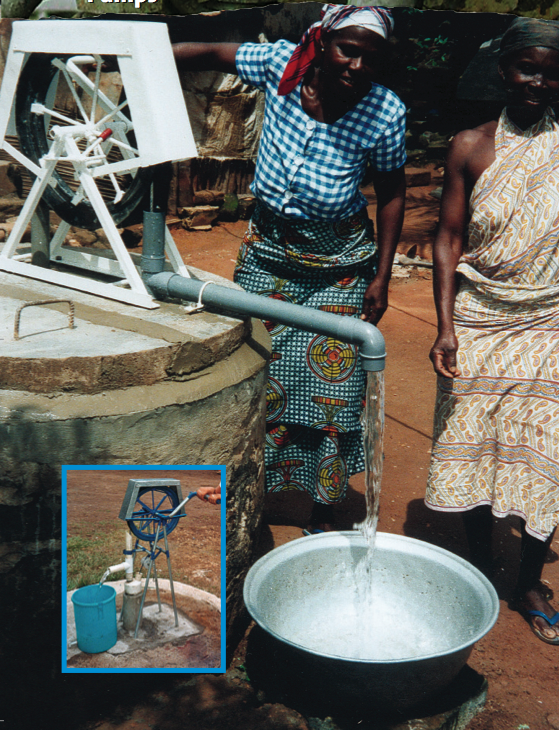Difference between revisions of "Treadle pump"
(icon) |
(text) |
||
| Line 1: | Line 1: | ||
[[Image:Treadle_pump_icon.png|right]] | [[Image:Treadle_pump_icon.png|right]] | ||
| − | + | The treadle pump for irrigation was | |
| + | |||
| + | developed in the late 1970's in Bangladesh. After wide-scale promotion by IDE International | ||
| + | |||
| + | Development Enterprise, they are now being produced in 300 local workshops and used by more | ||
| + | |||
| + | than one million poor rural families that otherwise could not have afforded an irrigation | ||
| + | |||
| + | pump. With this technology, many families have increased their income. Some farmers who | ||
| + | |||
| + | started with this pedal pump have now bought a motorized pump. The treadle pump is cost | ||
| + | |||
| + | effective; it cost US$ 20 in Bangladesh and generates US$ 100 or more per year. Together, | ||
| + | |||
| + | these pumps add over US$ 100 million every year to the GNP of Bangladesh. Production and | ||
| + | |||
| + | sales are now sustainable without any external aid. The treadle pump is also being promoted | ||
| + | |||
| + | in Africa where it is installed by organisations like Kickstart (former Approtec) and EW | ||
| + | |||
| + | Enterprise Works. Models of the treadle pump like the Moneymaker and the Soka-pump are now | ||
| + | |||
| + | widely used for small-scale "spray" irrigation. | ||
[[Image:Rope_pump.PNG|thumb|right|150px|[[Rope pump | Rope pump ]], (Victory model) on a hand-dug of 20 meters deep well, made in a local workshop in northern Ghana ]] | [[Image:Rope_pump.PNG|thumb|right|150px|[[Rope pump | Rope pump ]], (Victory model) on a hand-dug of 20 meters deep well, made in a local workshop in northern Ghana ]] | ||
Revision as of 14:33, 27 July 2007
The treadle pump for irrigation was
developed in the late 1970's in Bangladesh. After wide-scale promotion by IDE International
Development Enterprise, they are now being produced in 300 local workshops and used by more
than one million poor rural families that otherwise could not have afforded an irrigation
pump. With this technology, many families have increased their income. Some farmers who
started with this pedal pump have now bought a motorized pump. The treadle pump is cost
effective; it cost US$ 20 in Bangladesh and generates US$ 100 or more per year. Together,
these pumps add over US$ 100 million every year to the GNP of Bangladesh. Production and
sales are now sustainable without any external aid. The treadle pump is also being promoted
in Africa where it is installed by organisations like Kickstart (former Approtec) and EW
Enterprise Works. Models of the treadle pump like the Moneymaker and the Soka-pump are now
widely used for small-scale "spray" irrigation.

| Advantages | Disadvantages |
|---|---|
| Significantly cheaper than piston pumps. Easy to maintain. |
Not all introduction programs have been successful. |
Capacity
40 litres / min from 10 meters depth.
Costs
- US$ 20-120 depending on model.
Applying conditions
- Numbers: 50,000 in Nicaragua, 20,000 in Mexico, Honduras, Guatemala, Ghana, Zimbabwe, Tanaznia, Senegal.
- Range of depth: 1-35 meter (60 m with two cranks).
- Application Communal wells, houshold, irrigation.
- Cost of introduction: US$ 10,000-20,000 per project, including 20 pumps, engineering and hands-on training. US$ 60,000-100,000 per project, including 1,000 pumps, production workshop and hands-on training.
Rope pump building manual
PRACTICA foundation and the Technical Training Programme of the ETC Foundation (TTP/ETC) have put together a really excellent manual on how to build rope pumps (PDF, 2.5 Mbyte). It is an 86 page long document with detailed instructions.
External links
- Evaluations www.irc.nl
- Africa www.pumpaid.org
- General info www.ropepump.com
- How to build www.ropepumps.org
